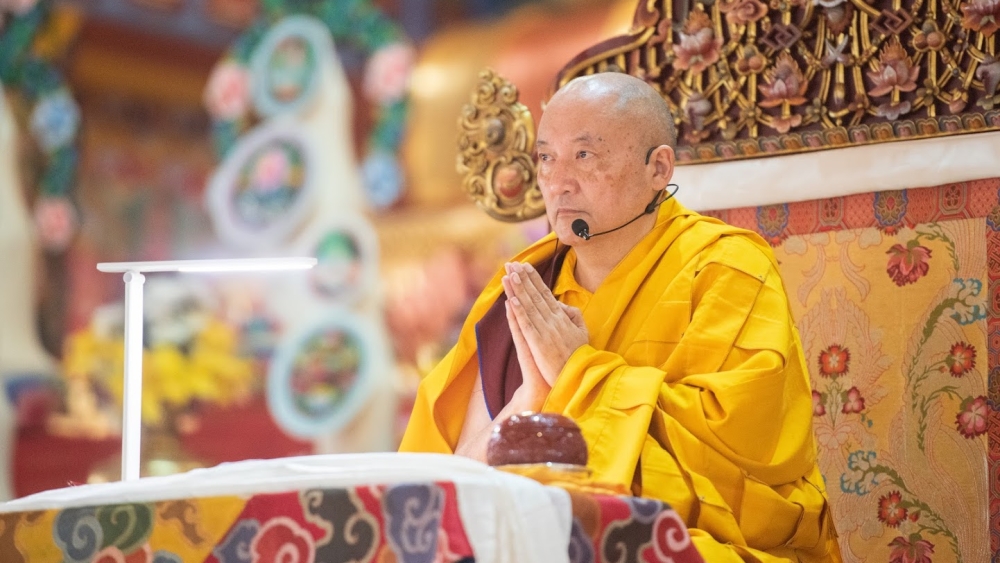Bokar Shedra Omar Chimey Ling
29 January 2023
The monks who attended the Kagyu Gunchoe have been joined by additional monks from Bokar, Rumtek, Ralang, Zurmang, Sonada and Phodong monasteries. The younger monks are being accommodated in tents. The nuns of Bokar Dolma Lekshay Doeguling Buddhist Institute have also joined, and the Monlam umzes are drawn from both monks and nuns.
The main shrine hall of Bokar monastery is decorated according to Monlam tradition. Great banners and drapes in the Buddhist colours hang down and the altar and stage are festooned with fresh, bright marigolds. From beneath the large golden Buddha, enthroned portraits of Kyabje Bokar Rinpoche and the Seventeenth Gyalwang Karmapa survey the congregation. Behind them, on the altar, is an array of tormas large and small, great pyramids of fruit and polished bowls of traditional offerings. The five great tormas contain central images of the three Dakpo Kagyu forefathers, Marpa, Milarepa, and Gampopa, and two eminent Karmapas, First Karmapa Dusum Khyenpa and Eighth Karmapa Mikyo Dorje. The upper images in the tormas each represent one of the Buddhas of the five Buddha families.
A small pagoda shrine to the infant Buddha is positioned centrally in front of the altar. This will be used daily during the Twenty-Branch Monlam, especially during the section “Branch of Ablutions” when the ritual master symbolically washes, dries, anoints, and clothes the statue.
On 28th January, Kyabje Gyaltsab Rinpoche returned to Bokar monastery in order to preside over the first day of the Monlam and to give the teaching on the first day.
Just as the sky was beginning to lighten, Rinpoche was escorted into the shrine hall to give the Mahayana Sojong vows and lead the first session of prayers. He, Bokar Rinpoche and Khenchen Lodroe Donyo Rinpoche lit the three wicks of the great butter lamp which stands in front of the pagoda shrine. After everybody had prostrated three times to the beating of a wooden gong, Gyaltsab Rinpoche bestowed the Sojong vows and the first session of the Monlam prayers began. Celebratory sweet rice and a breakfast of tea and bread were served to everyone. At the back of the shrine hall the congregation was swelled by laypeople.
After a short tea-break, Gyaltsab Rinpoche presented prizes to the winners of the Kagyu Gunchoe debate competition. This year, unlike previous years, the monks were not representing their individual monasteries but in mixed groups. Two groups were given awards in each of the following shedra topics: Dupa (Collected Topics ie.basic logic); Lorig (Types of Mind); Takrig (Types of Evidence); Lower and Upper Tsema (Epistemology); Lower and Upper Pharchin (Skt. Prajñāpāramitā – “The Transcendence of Wisdom”). There were also awards for individual achievements in defending a position, presenting an argument, and effort.
Then came lunchtime and healthy, vegetarian food was freely available to all who had attended. Following Monlam tradition, the gelongs have their own private area, where they are seated in rows according to status (which depends on the length of time since their ordination), and sit in silence. They are served individually in their places and eat from alms bowls. There is a dining hall designated for VIPs such as rinpoches, tulkus, khenpos and important laypeople. The nuns have a separate dining area, and, finally, there is a dining area for novices and laypeople. All the food is prepared in the monastery kitchen by five cooks, including one who has come especially from the Kagyu Monlam headquarters in Bodhgaya, and monk helpers.
For the first four days of the Special Monlam, the order of the day has been changed. The session which is usually second in the programme has been moved to after lunch in order to facilitate the Gyalwang Karmapa’s teachings. Today, the original programme changed slightly too as Kyabje Gyaltsab Rinpoche gave a teaching on the Seven Points of Mind Training [See separate transcript]. He then led the dedication prayers for the living and the deceased.
The final session followed the Monlam Book and included aspiration prayers, long life prayers for His Holiness the 14th Dalai Lama, the Gyalwang Karmapa and other Kagyu lamas, and offerings to the Protectors. The session concluded with Jamgon Kongtrul Lodoe Thaye’s famous Aspiration for the Well-Being of Tibet, Jowo Atisha’s Dharma Blaze Aspiration, and Karmapa Mikyo Dorje’s The One Who Taught the Truth.
In accordance with Monlam tradition, a group of monks who have completed their three-year retreat are meeting together for two hours each evening to practise the Six Yogas of Naropa. Their achievements will be celebrated in the Cotton-Clad Procession on Day Seven of the Monlam.



